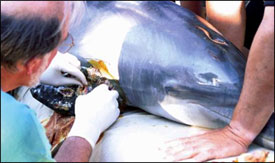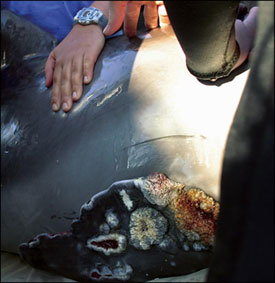|
Intentionally throwing monofilament line into state waters is illegal.
“People need to understand the damage line can do,” Wells said. “Out of sight, out of mind is not an appropriate approach.”
After spotting the otherwise healthy Toro several times, Mote staff decided to take action.
Mote’s preference is to catch an injured dolphin in a net, remove the fishing line on the spot, treat the wounds and release it.
“Bringing dolphins here is the last resort,” Wells said. “We don’t want them to get too used to people, and we don’t want to run the risk of transporting them.”
But when scientists tracked Toro down Tuesday, they realized the preferred method was not an option.
“She was hanging in there — she hadn’t started crashing, but she was close to it,” Manire said. “She was so close to the edge that in two days, she could have been dead. If the infection gets into the blood stream, it kills her in 12 to 24 hours.”
By 9:10 a.m. Wednesday, Manire had finished cutting; at 9:15, volunteers were walking Toro around in a 30,000-gallon tank; at 9:23, she was swimming on her own.
“We trimmed away a lot of that dead tissue; the bleeding has stopped, and she’s awake,” Manire said. “Now we’ll watch her and deal with the acute wounds and infection instead of the chronic stuff.”
Until she is healed, Mote staff and volunteers will catch Toro every day, clean the wounds and administer antibiotics and anti-fungal medicine.
A close up shot of the injury to Toro’s
right pectoral fin caused by fishing line.
This picture was taken before Dr. Manire
operated on the wound.
Toro will also receive an alternative treatment:
A device that emits infrared light will be placed
near Toro’s wounds. The infrared light will create
heat in the tissues to stimulate blood flow and help
the wounds heal.
Manire recently used the infrared device to
treat third-degree sunburns on Jack, a
bottlenose dolphin that got stranded in
October near Jacksonville.
|

